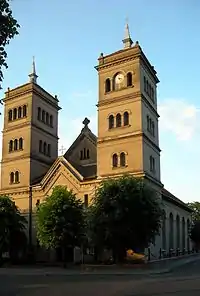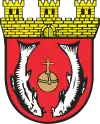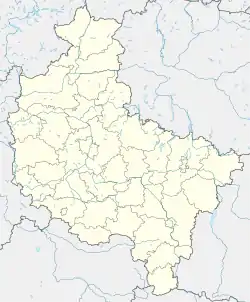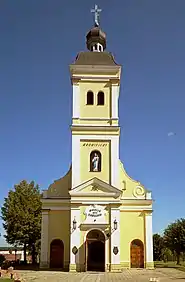Szamocin
Szamocin [ʂaˈmɔt͡ɕin] (German: Samotschin, 1943-45: Fritzenstadt) is a town in Chodzież County, Greater Poland Voivodeship, Poland.
Szamocin | |
|---|---|
 Saint Peter and Paul Church | |
 Coat of arms | |
 Szamocin  Szamocin | |
| Coordinates: 53°1′49″N 17°7′14″E | |
| Country | |
| Voivodeship | Greater Poland |
| County | Chodzież |
| Gmina | Szamocin |
| First mentioned | 1364 |
| Town rights | 1748 |
| Government | |
| • Mayor | Eugeniusz Wiktor Kucner |
| Area | |
| • Total | 4.67 km2 (1.80 sq mi) |
| Population (2006) | |
| • Total | 4,267 |
| • Density | 910/km2 (2,400/sq mi) |
| Time zone | UTC+1 (CET) |
| • Summer (DST) | UTC+2 (CEST) |
| Postal code | 64-820 |
| Area code(s) | +48 67 |
| Car plates | PCH |
| Website | http://www.szamocin24.pl |
History

Szamoczino in the Piast-ruled Kingdom of Poland was first mentioned in a 1364 deed, although it surely existed earlier and was probably founded in the 12th century. It was a private village of Polish nobility, administratively located in the Kcynia County in the Kalisz Voivodeship in the Greater Poland Province of the Polish Crown.[1] It received town privileges from the hands of King Augustus III of Poland in 1748.
In the First partition of Poland in 1772 the town was annexed by the Kingdom of Prussia, fell to the Napoleonic Duchy of Warsaw in 1807 and was restored to Prussia in 1815, whereafter it was governed within the Kreis Kolmar in Posen, part of the Grand Duchy of Posen. During the Industrial Revolution, the town evolved to a centre of the weaving industry. From 1871 it was part of Germany. After World War I, in 1918, Poland regained independence, and the Greater Poland Uprising broke out, which goal was to reintegrate the region with the reborn Polish state. On January 13, 1919, the town was captured by Polish insurgents led by Maksymilian Bartsch, but was lost to Germany on the same day.[2] The insurgents made an unsuccessful attempt to recapture the town,[2] however in accordance to the Treaty of Versailles it was still reintegrated with the newly established Second Polish Republic in 1921.
After the joint German-Soviet invasion of Poland, which started World War II, in September 1939, it was captured by Germany, and already on September 17, the Germans murdered two Polish boy scouts in the town.[3] Inhabitants of Szamocin were also among 41 Poles murdered in the nearby village of Morzewo on November 7, 1939.[4] On December 10–12, 1939, the Germans expelled hundreds of Polish and Jewish inhabitants from the town to the General Government.[5] In 1943, the German administration renamed the town Fritzenstadt, to erase traces of Polish origin. After the German occupation ended in 1945, the original Polish name was restored.
Notable people
- Ernst Toller (1893–1939), playwright
- Bartosz Ślusarski (born 1981), footballer
- Radosław Cierzniak (born 1983), footballer
References
- Atlas historyczny Polski. Wielkopolska w drugiej połowie XVI wieku. Część I. Mapy, plany, Instytut Historii Polskiej Akademii Nauk, Warszawa, 2017, p. 1b (in Polish)
- "13 stycznia 1919". Instytut Pamięci Narodowej (in Polish). Retrieved 3 October 2020.
- Maria Wardzyńska, Był rok 1939. Operacja niemieckiej policji bezpieczeństwa w Polsce. Intelligenzaktion, IPN, Warszawa, 2009, p. 116 (in Polish)
- Maria Wardzyńska, Był rok 1939. Operacja niemieckiej policji bezpieczeństwa w Polsce. Intelligenzaktion, p. 200
- Maria Wardzyńska, Wysiedlenia ludności polskiej z okupowanych ziem polskich włączonych do III Rzeszy w latach 1939-1945, IPN, Warszawa, 2017, p. 157 (in Polish)
- "Klub Sportowy Sokół Szamocin" (in Polish). Retrieved 3 October 2020.